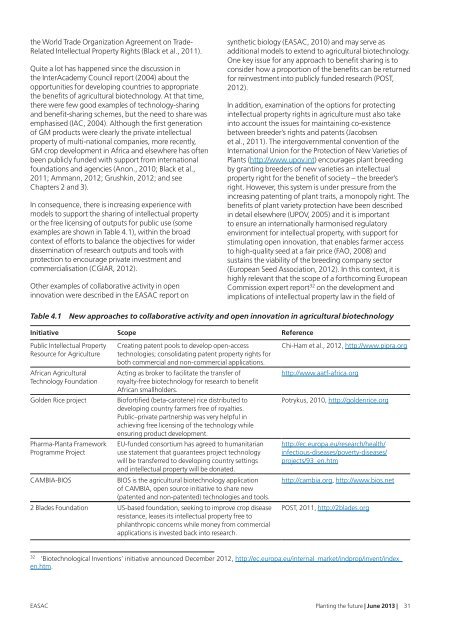Planting the future: opportunities and challenges for using ... - EASAC
Planting the future: opportunities and challenges for using ... - EASAC
Planting the future: opportunities and challenges for using ... - EASAC
You also want an ePaper? Increase the reach of your titles
YUMPU automatically turns print PDFs into web optimized ePapers that Google loves.
<strong>the</strong> World Trade Organization Agreement on Trade-<br />
Related Intellectual Property Rights (Black et al., 2011).<br />
Quite a lot has happened since <strong>the</strong> discussion in<br />
<strong>the</strong> InterAcademy Council report (2004) about <strong>the</strong><br />
<strong>opportunities</strong> <strong>for</strong> developing countries to appropriate<br />
<strong>the</strong> benefits of agricultural biotechnology. At that time,<br />
<strong>the</strong>re were few good examples of technology-sharing<br />
<strong>and</strong> benefit-sharing schemes, but <strong>the</strong> need to share was<br />
emphasised (IAC, 2004). Although <strong>the</strong> first generation<br />
of GM products were clearly <strong>the</strong> private intellectual<br />
property of multi-national companies, more recently,<br />
GM crop development in Africa <strong>and</strong> elsewhere has often<br />
been publicly funded with support from international<br />
foundations <strong>and</strong> agencies (Anon., 2010; Black et al.,<br />
2011; Ammann, 2012; Grushkin, 2012; <strong>and</strong> see<br />
Chapters 2 <strong>and</strong> 3).<br />
In consequence, <strong>the</strong>re is increasing experience with<br />
models to support <strong>the</strong> sharing of intellectual property<br />
or <strong>the</strong> free licensing of outputs <strong>for</strong> public use (some<br />
examples are shown in Table 4.1), within <strong>the</strong> broad<br />
context of ef<strong>for</strong>ts to balance <strong>the</strong> objectives <strong>for</strong> wider<br />
dissemination of research outputs <strong>and</strong> tools with<br />
protection to encourage private investment <strong>and</strong><br />
commercialisation (CGIAR, 2012).<br />
O<strong>the</strong>r examples of collaborative activity in open<br />
innovation were described in <strong>the</strong> <strong>EASAC</strong> report on<br />
syn<strong>the</strong>tic biology (<strong>EASAC</strong>, 2010) <strong>and</strong> may serve as<br />
additional models to extend to agricultural biotechnology.<br />
One key issue <strong>for</strong> any approach to benefit sharing is to<br />
consider how a proportion of <strong>the</strong> benefits can be returned<br />
<strong>for</strong> reinvestment into publicly funded research (POST,<br />
2012).<br />
In addition, examination of <strong>the</strong> options <strong>for</strong> protecting<br />
intellectual property rights in agriculture must also take<br />
into account <strong>the</strong> issues <strong>for</strong> maintaining co-existence<br />
between breeder’s rights <strong>and</strong> patents (Jacobsen<br />
et al., 2011). The intergovernmental convention of <strong>the</strong><br />
International Union <strong>for</strong> <strong>the</strong> Protection of New Varieties of<br />
Plants (http://www.upov.int) encourages plant breeding<br />
by granting breeders of new varieties an intellectual<br />
property right <strong>for</strong> <strong>the</strong> benefit of society – <strong>the</strong> breeder’s<br />
right. However, this system is under pressure from <strong>the</strong><br />
increasing patenting of plant traits, a monopoly right. The<br />
benefits of plant variety protection have been described<br />
in detail elsewhere (UPOV, 2005) <strong>and</strong> it is important<br />
to ensure an internationally harmonised regulatory<br />
environment <strong>for</strong> intellectual property, with support <strong>for</strong><br />
stimulating open innovation, that enables farmer access<br />
to high-quality seed at a fair price (FAO, 2008) <strong>and</strong><br />
sustains <strong>the</strong> viability of <strong>the</strong> breeding company sector<br />
(European Seed Association, 2012). In this context, it is<br />
highly relevant that <strong>the</strong> scope of a <strong>for</strong>thcoming European<br />
Commission expert report 32 on <strong>the</strong> development <strong>and</strong><br />
implications of intellectual property law in <strong>the</strong> field of<br />
Table 4.1<br />
New approaches to collaborative activity <strong>and</strong> open innovation in agricultural biotechnology<br />
Initiative Scope Reference<br />
Public Intellectual Property<br />
Resource <strong>for</strong> Agriculture<br />
African Agricultural<br />
Technology Foundation<br />
Golden Rice project<br />
Pharma-Planta Framework<br />
Programme Project<br />
CAMBIA-BIOS<br />
Creating patent pools to develop open-access<br />
technologies; consolidating patent property rights <strong>for</strong><br />
both commercial <strong>and</strong> non-commercial applications.<br />
Acting as broker to facilitate <strong>the</strong> transfer of<br />
royalty-free biotechnology <strong>for</strong> research to benefit<br />
African smallholders.<br />
Bio<strong>for</strong>tified (beta-carotene) rice distributed to<br />
developing country farmers free of royalties.<br />
Public–private partnership was very helpful in<br />
achieving free licensing of <strong>the</strong> technology while<br />
ensuring product development.<br />
EU-funded consortium has agreed to humanitarian<br />
use statement that guarantees project technology<br />
will be transferred to developing country settings<br />
<strong>and</strong> intellectual property will be donated.<br />
BIOS is <strong>the</strong> agricultural biotechnology application<br />
of CAMBIA, open source initiative to share new<br />
(patented <strong>and</strong> non-patented) technologies <strong>and</strong> tools.<br />
2 Blades Foundation US-based foundation, seeking to improve crop disease<br />
resistance, leases its intellectual property free to<br />
philanthropic concerns while money from commercial<br />
applications is invested back into research.<br />
Chi-Ham et al., 2012, http://www.pipra.org<br />
http://www.aatf-africa.org<br />
Potrykus, 2010, http://goldenrice.org<br />
http://ec.europa.eu/research/health/<br />
infectious-diseases/poverty-diseases/<br />
projects/93_en.htm<br />
http://cambia.org, http://www.bios.net<br />
POST, 2011, http://2blades.org<br />
32<br />
‘Biotechnological Inventions’ initiative announced December 2012, http://ec.europa.eu/internal_market/indprop/invent/index_<br />
en.htm.<br />
<strong>EASAC</strong> <strong>Planting</strong> <strong>the</strong> <strong>future</strong> | June 2013 | 31


